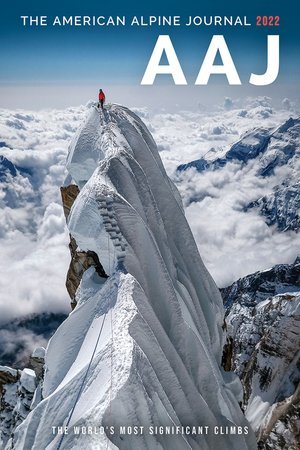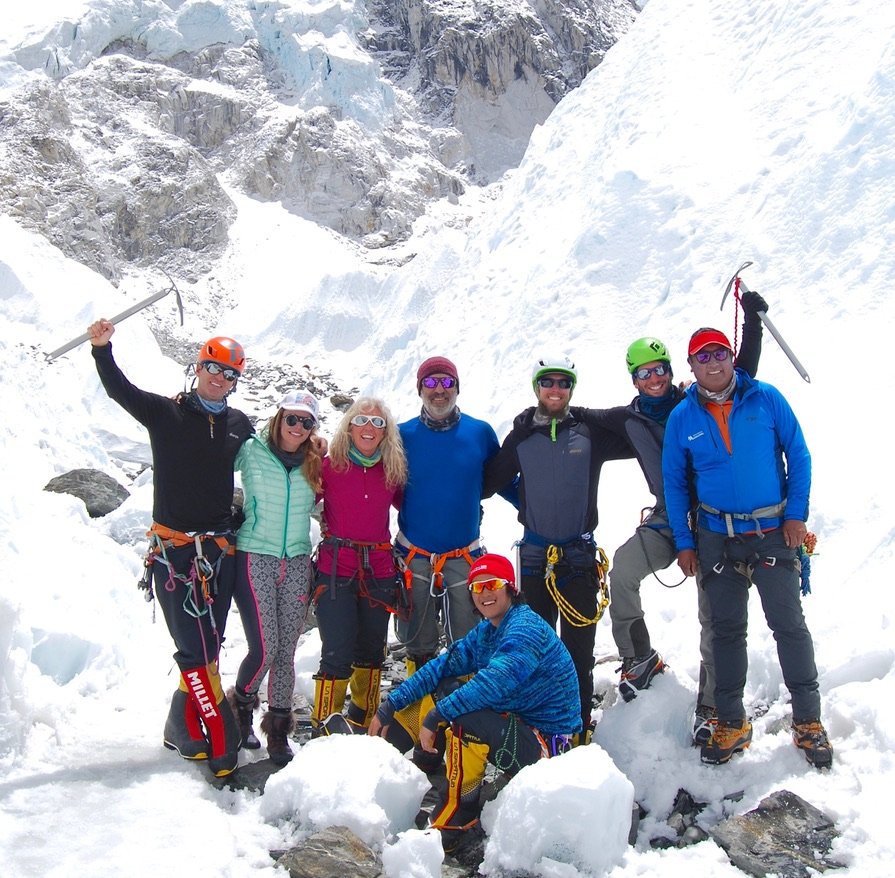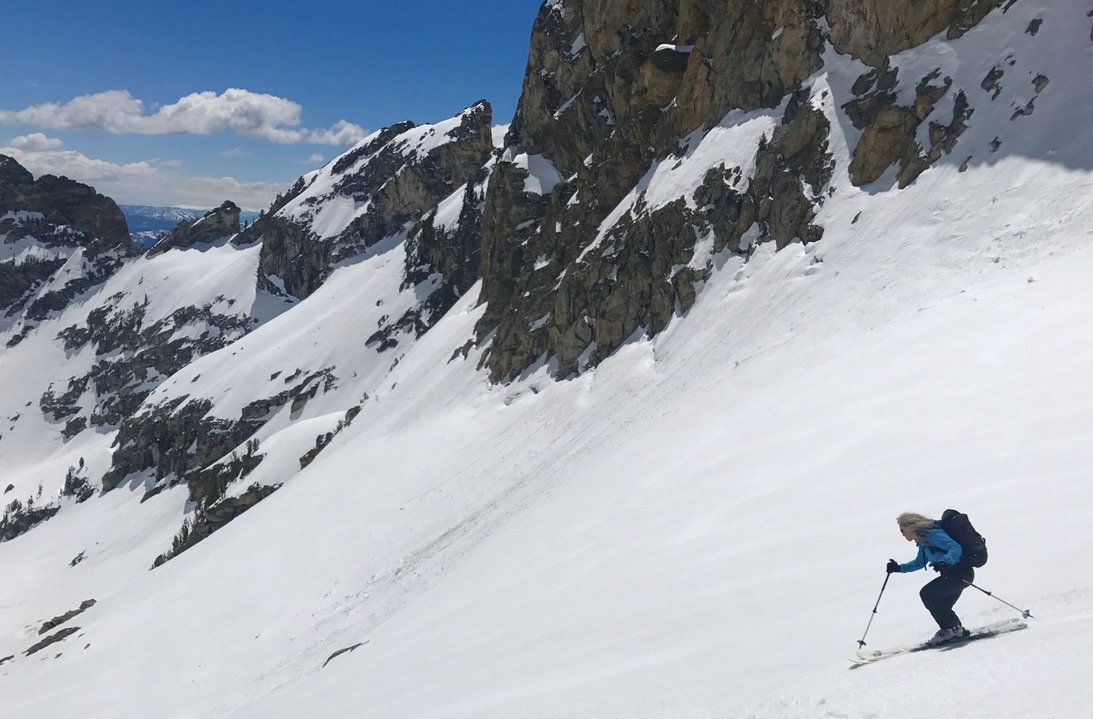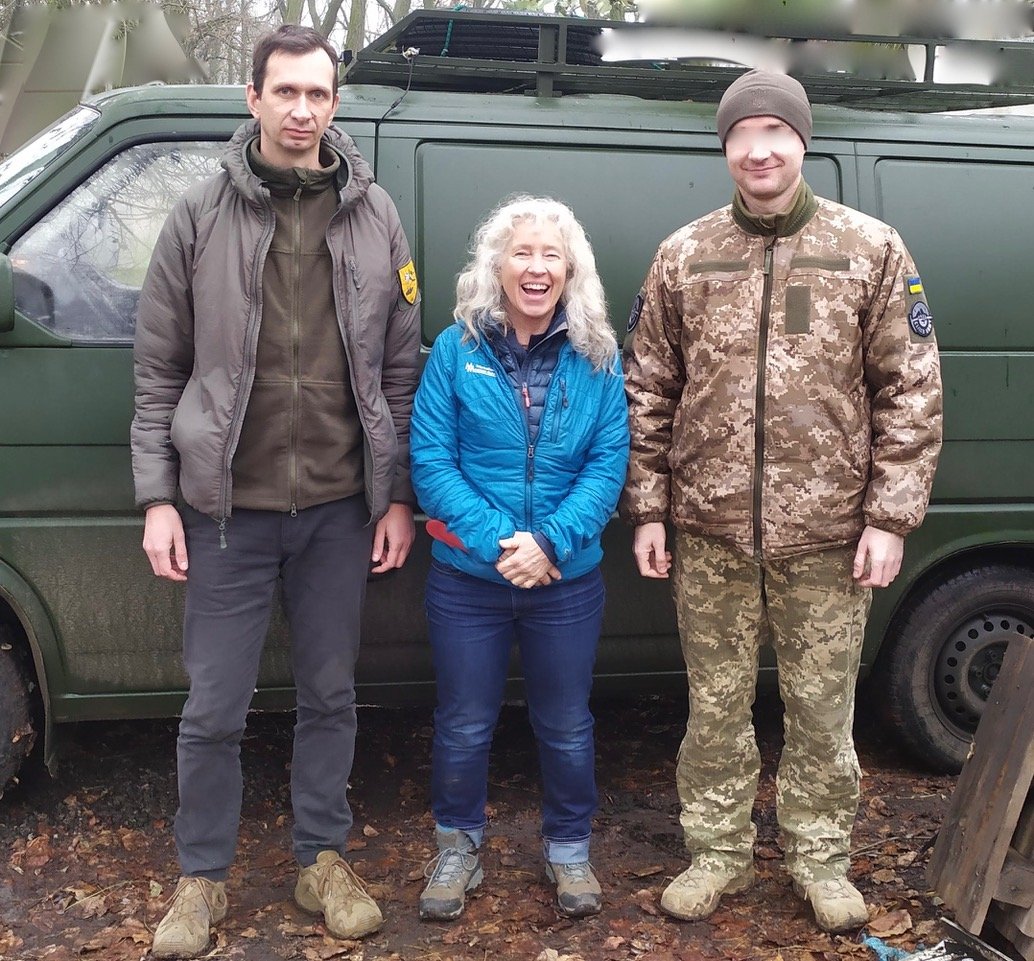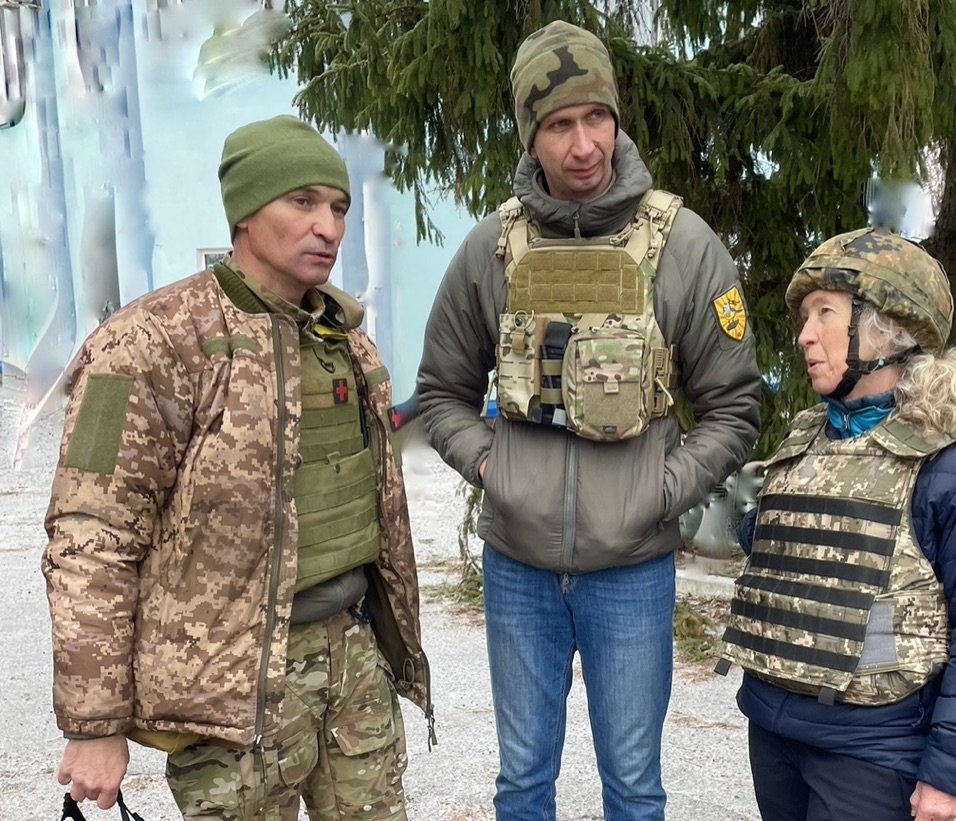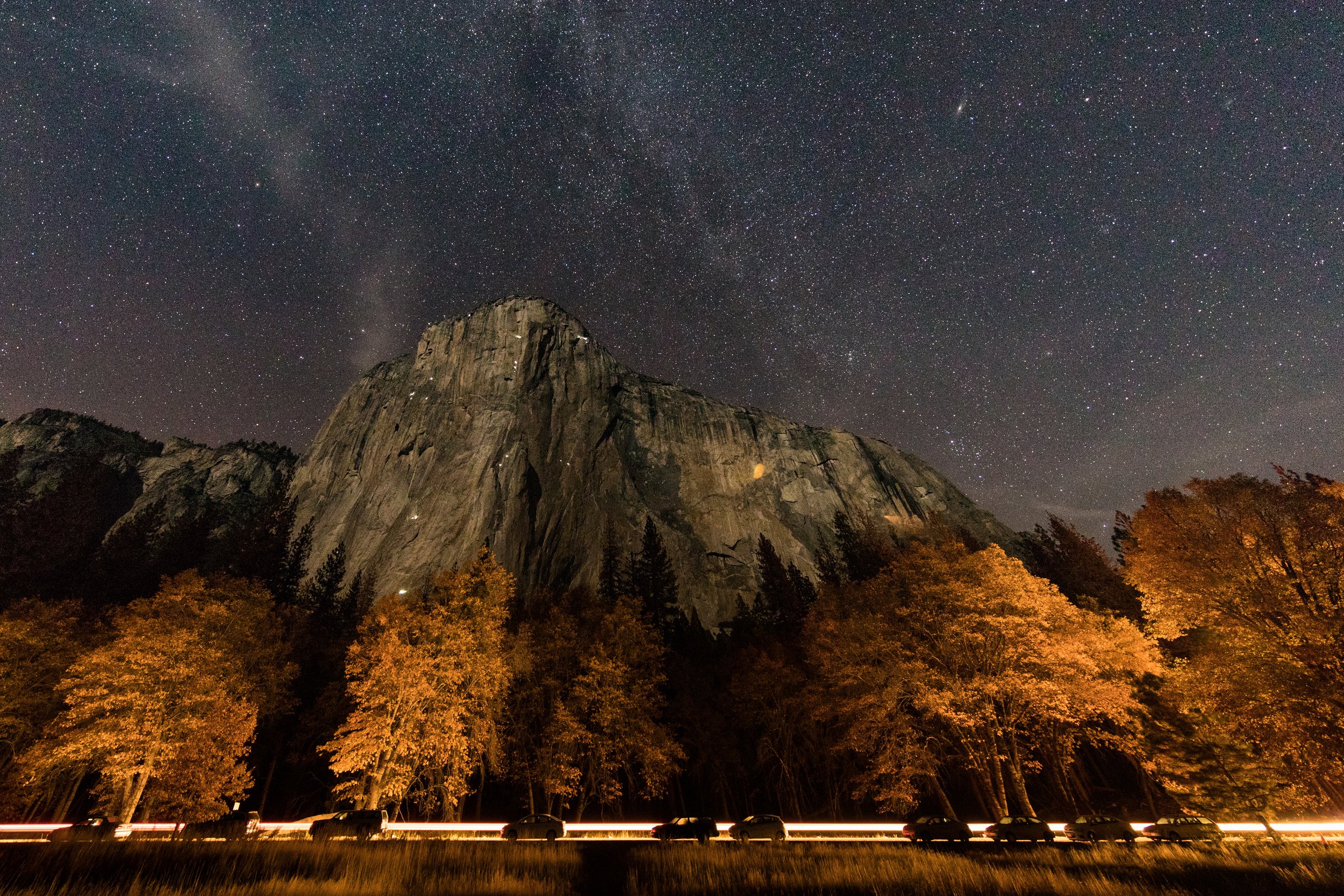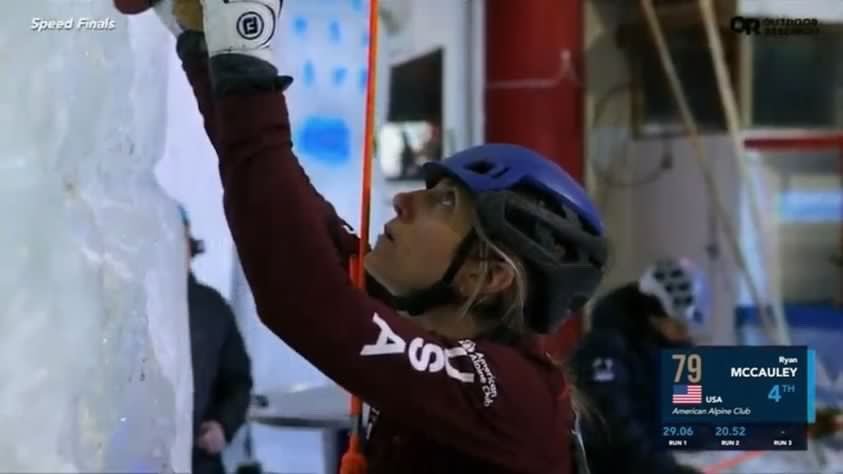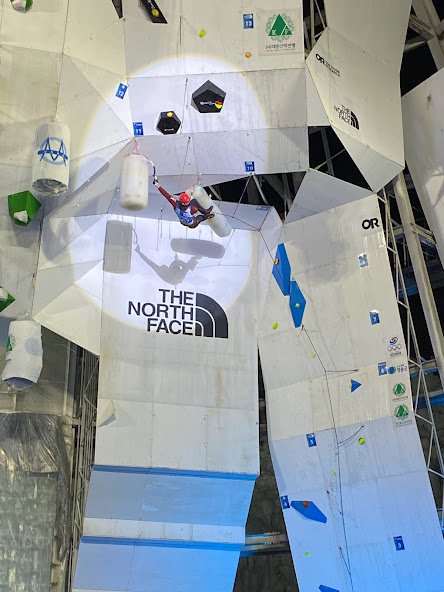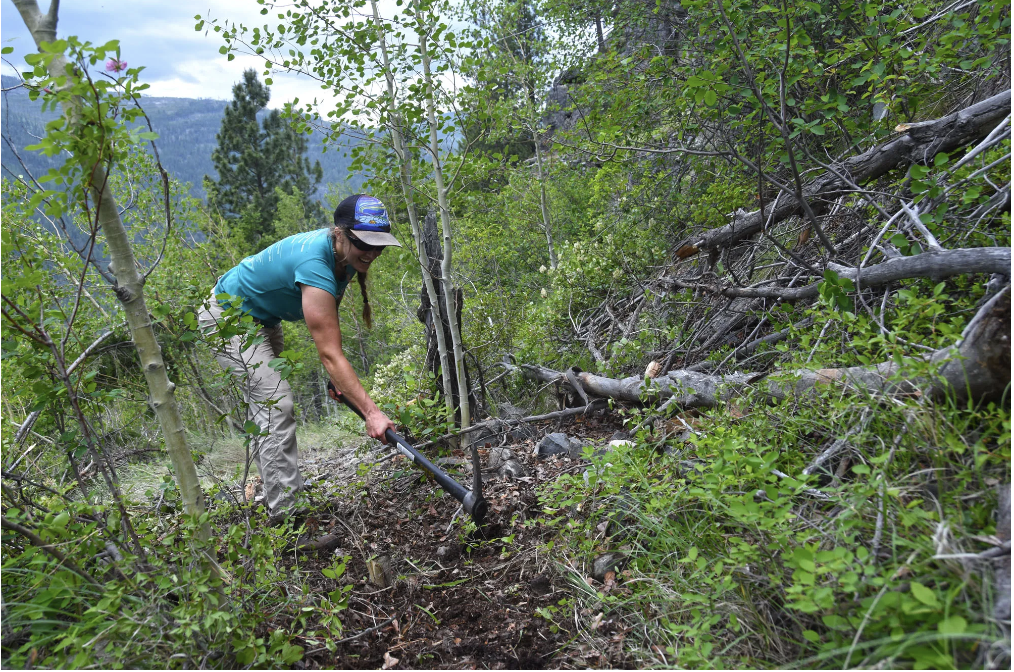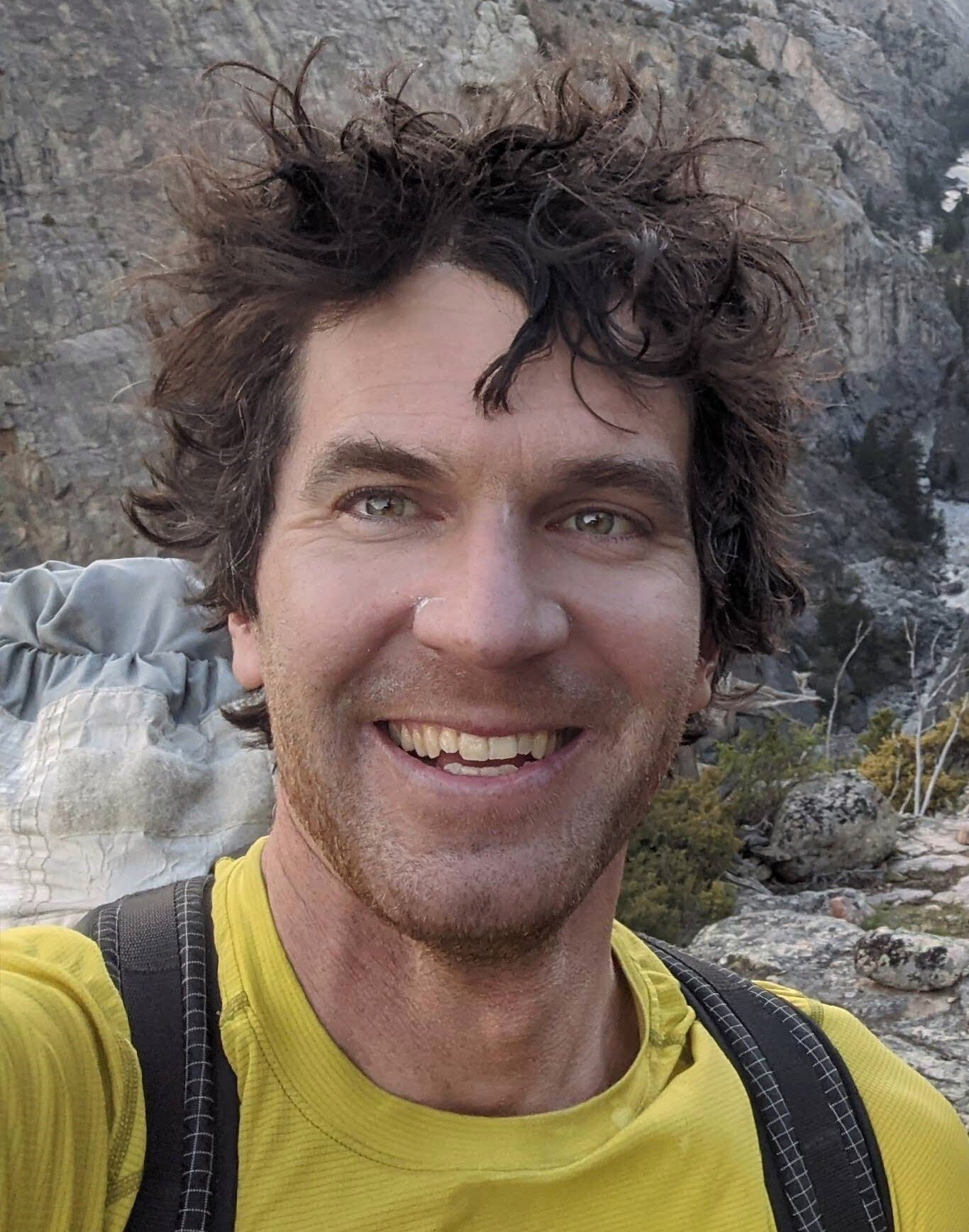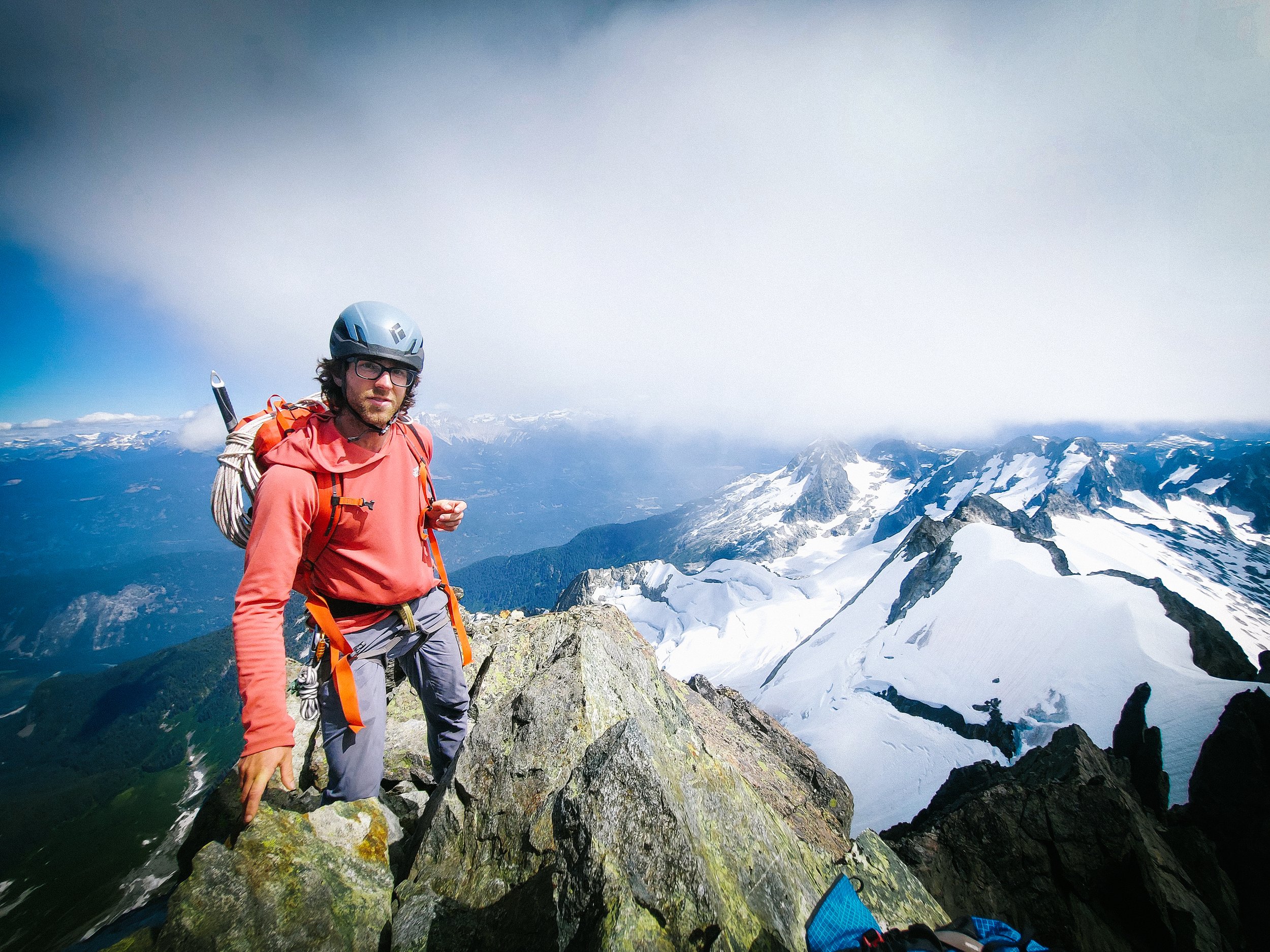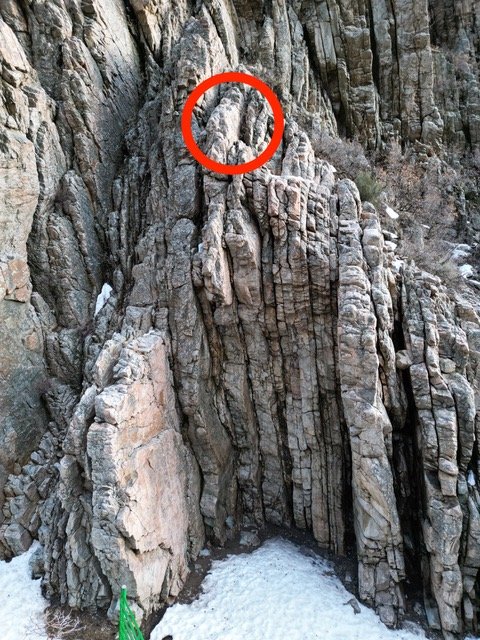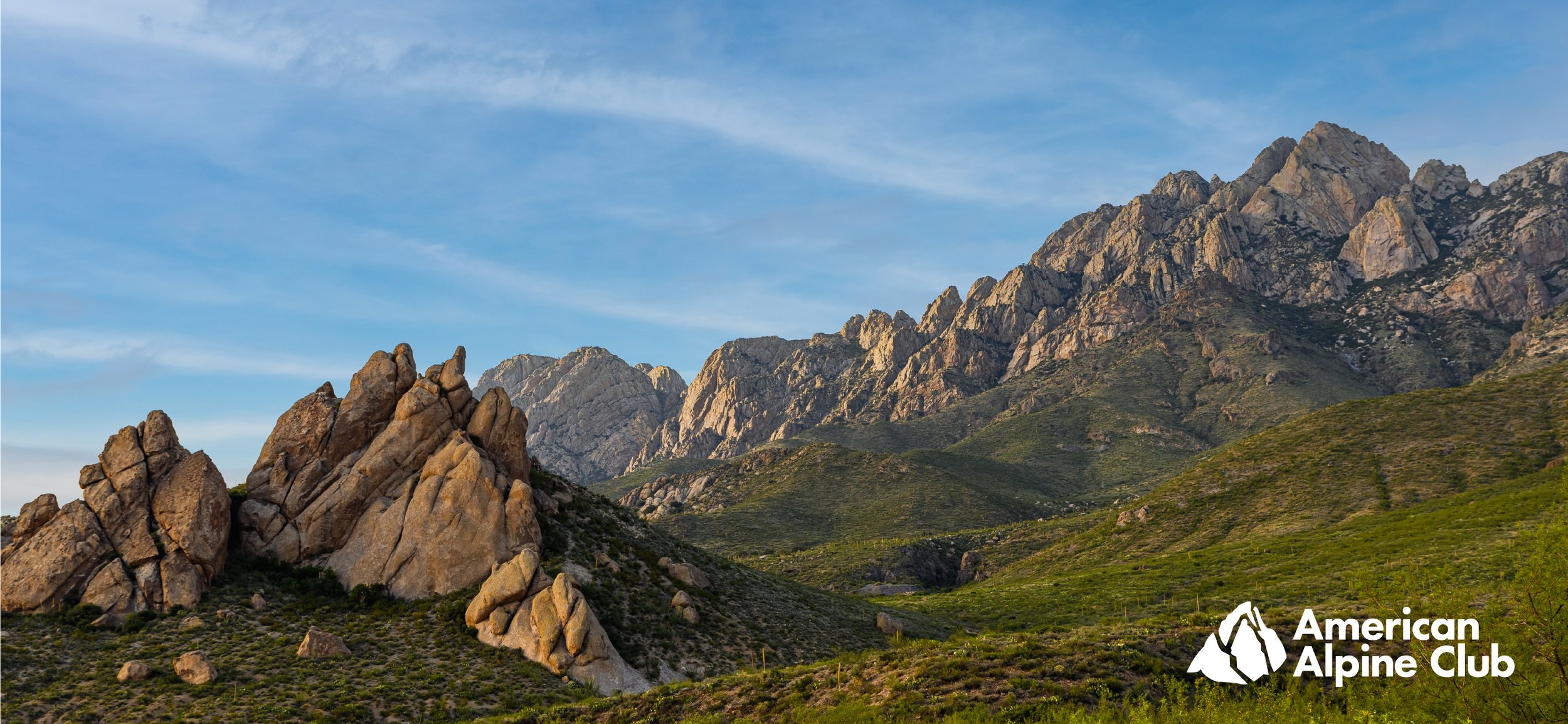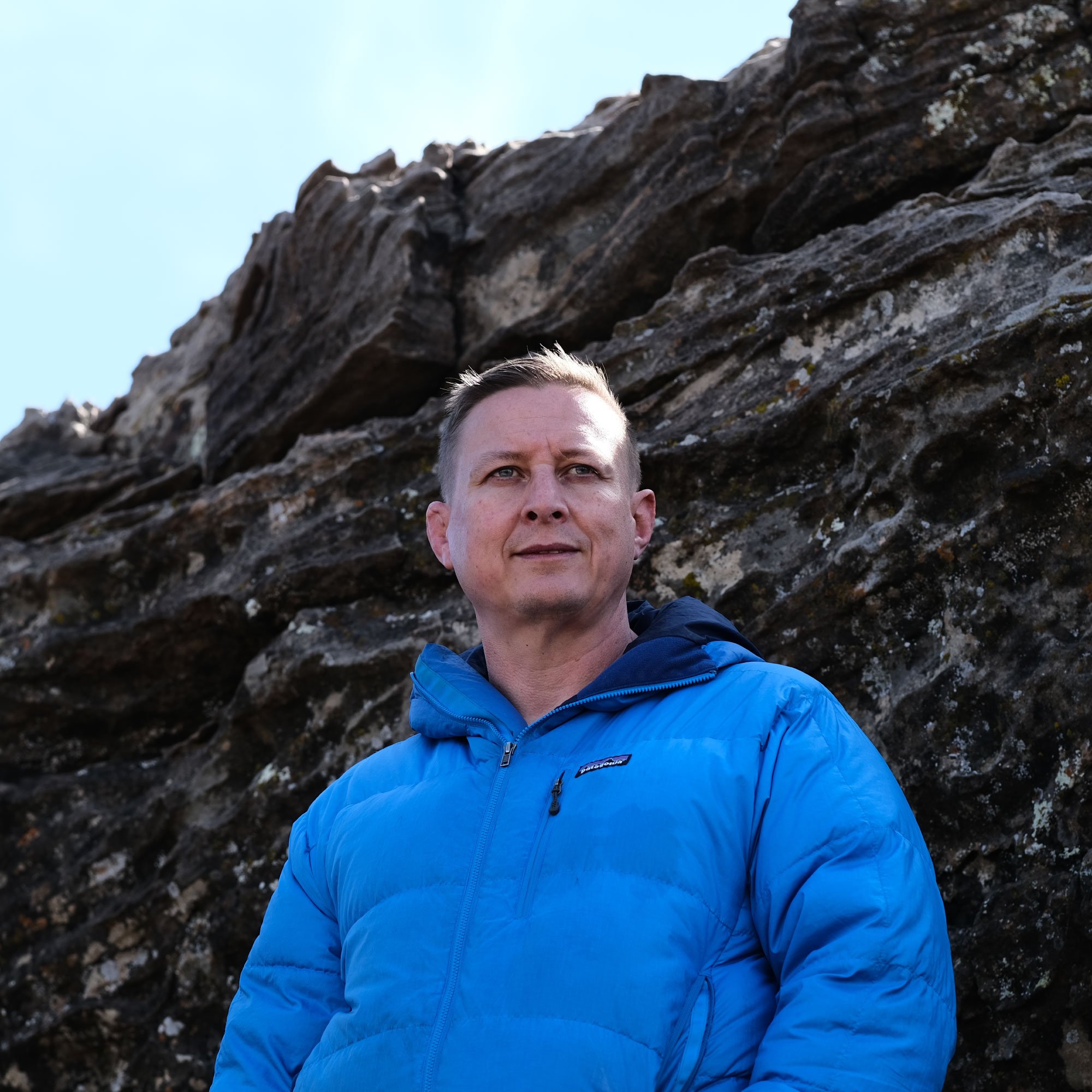Have you ever wondered: what’s at the root of Alex Honnold’s need for speed? In this episode of the podcast, we sat down with the ever-fascinating Alex Honnold, and put him in conversation with one of ulta running’s forefathers and one of the inventors of the FKT concept, or “fastest known time,” the one and only Buzz Burrell. In this episode, we took inspiration from Alex, who blends sports like running and rock climbing to create massive link-ups like the HURT and the CUDL, to investigate the philosophies behind climbing speed records, ultras, and mountain traverses and link-ups. Why are we so obsessed with speed in the mountains? How do speed records and first ascents play off each other? And what can putting ultra runners and speed record holders together in conversation reveal about these sports we love? The iconic Alex Honnold and Buzz Burrell weigh in on all this and more.
The Line — May 2023
The Line is the monthly newsletter of the American Alpine Journal.
Bivouac on the southwest face of Ingolfsfjeld during the ’75 expedition. Photo by Jim Davenport.
GREENLAND’S GIANT MYSTERY WALL
The huge southwest face of Ingolfsfjeld, with 63 pitches of climbing, after a snowstorm. Photo by Steve Chadwick.
In the early to mid-1970s, one of the great challenges of arctic climbing was the southwest face of Ingolfsfjeld, an enormous wall 120 kilometers northeast of Tasiilaq on Greenland’s east coast. Visible from the sea, the peak was first climbed by its northeast ridge in 1971, by a Croatian duo, but the biggest face—rising at least 1,200 meters—remained unclimbed despite several attempts.
In 1975, a six-person British expedition finally succeeded, with three of the climbers making the final push to the summit. The resulting route had around 2,000 meters of climbing and was graded ED+ UIAA VI+ (5.10) A3, an extremely difficult wilderness wall for the era. Yet the climb has been largely forgotten, and until this year, no account had been published in the AAJ.
Expedition member Steve Chadwick has described this remarkable expedition at length in a previously unpublished article, now available at the AAJ website, along with photos, a topo, and a pitch by pitch summary of the 63-pitch climb, which likely has never been repeated. (The last known attempt on any route up the mountain was in 1986!) An overview of the 1975 climb, written by senior editor Lindsay Griffin, will appear in AAJ 2023, which will be mailed in late summer.
Introduction to Keith Myhill’s pitch-by-pitch description of the route, which totaled 6,640 feet of climbing. A link to the full description is in Steve Chadwick’s article at our website.
MINI-EPIC(S)
Mark Allen starts the team’s ascent of Chimaphila (470m, IV AI4) on Black Spire in the North Cascades. Photo by Jesse Charles.
Winter climbing is hard on climbers—and on their approach vehicles. Last winter, Mark Allen, Jesse Charles, and Seth Keena snowmobiled about 25 miles along closed Highway 20 in the North Cascades to make the first ascent of the east face of Black Spire by a varied ice line. Late in the day, they skied back to the unplowed road and mounted their sleds for the ride back to the car. Soon, the troubles began.
Keena opens his report for the upcoming AAJ 2023 with a description of his body slamming into the handlebars of his 1999 Yamaha Phazer. “I had acquired my snow machine for a bargain price, with the caveat that it had an ‘intermittent electrical issue, but not that big of a deal.’” he wrote. “Now, while cruising at 55 mph, the engine and lights had cut off, bringing sudden darkness and deceleration.”
Keena restarted the sled and followed his partners toward the plowed road. “Eventually we all made it back to Mark’s truck at the end of the plowed highway,” he wrote. “But, once again, we quietly faced the power of winter when we discovered the truck’s battery was dead.”
At least their phones still worked. A pleading call summoned help. Said Keena: “A friend is someone who, at 11:30 p.m., leaves their warm bed and drives to the end of the highway to jump-start your dead battery: Thank you, Patrick Murphy, you are a true friend.”
Without apparent irony, they called the new route Chimaphila (“winter lover”). Read Keena’s full AAJ report here.
Join the Club—United We Climb.
Get the AAJ Sent to You Annually
Partner-level members receive The American Alpine Journal book every year. Documenting mountain exploration and the year’s most significant ascents through first-person reports and photos, it’s an essential historical record and a feast of inspiration.
Rescue & Medical Expense Coverage
Climbing can be a risky pursuit, but one worth the price of admission. Partner-level members and up receive $7,500 in rescue services and $5,000 in emergency medical expense coverage. Looking for deeper coverage? Sign up for the Leader level and receive $300k in rescue services.
DENALI’S EAST BUTTRESS:
A 60-YEAR RETROSPECTIVE
Some years ago, Peter Lev, one member of the team that made the first ascent of Denali’s east buttress, published a photo-filled retrospective of the expedition. Lev summited on May 25, 1963, along with Rod Newcomb and Al Read. The other teammates were Warren Bleser, Jed Williamson, and Fred Wright. Here, we bring Lev’s images to light with a gallery of the marvelous photos from his piece. (Click on the images for captions.) You can download the complete retrospective in PDF form by following a link at the end of Read’s feature article in the 1964 AAJ.
Shop the AAJ Collection
Sign Up for AAC Emails
The Line is the newsletter of the American Alpine Journal (AAJ), emailed to more than 80,000 climbers each month. Find the archive of past editions here. Interested in supporting this online publication? Contact Billy Dixon for opportunities. Suggestions? Email us: [email protected].
10th Mountain Division to Memorialize AAC Member John McCown II
John McCown rappelling for a August 1942 photo shoot for Life Magazine. This image appeared in the Nov. 9, 1942 issue. Photos courtesy Private Collection of McCown Family.
On June 21st, 2023, the history of the US Army’s 10th Mountain Division and the legacy of the American Alpine Club will collide when the Division renames its Light Fighter School in honor of AAC member First Lieutenant John Andrew McCown II.
The memorialization will recognize McCown’s service to his country in WWII. Not only did McCown instruct 10th Mountain Division troops in mountaineering and climbing tactics. He played a pivotal role in the unit’s signature action: a nighttime assault of Italy’s Riva Ridge that helped break Hitler’s Gothic Line and end the war in Europe.
In honor of his impact, the 10th Mountain Division’s Light Fighter School will now be known as the 1LT John Andrew McCown II Light Fighter School building.
***
Climber, former American Alpine Journal editor, and Alpinist co-founder Christian Beckwith was writing a history of Teton mountaineering when he discovered that Teton climbers of the 1930s played an integral role in the development of the 10th Mountain Division. As he continued his research in the AAC Library and Denver Public Library archives, he found that the unit known widely as “America’s ski troops” owe much of their inception and development to American climbers in general and the AAC in particular.
As he dug deeper, Beckwith discovered an incontrovertible link between the modern era of recreation in America—particularly the modern era of climbing—and the skills, equipment, and tactics that some of the best and the brightest mountaineers brought to the 10th Mountain Division. He also uncovered a deep connection between the AAC and the 10th Mountain Division—especially how the AAC helped develop the gear, tactics, and clothing the 10th Mountain Division would use in action—and that, as Army surplus after the war, would help fuel the birth of the outdoor recreation industry.
John Andrew McCown II in the Tetons in 1939. Photos courtesy Private Collection of McCown Family.
Recently, Beckwith began a book and podcast called Ninety-Pound Rucksack that tells the true story of John McCown, the 10th Mountain Division and the dawn of outdoor recreation in America, all from the perspective of climbers. He also began serving as an advisor to the current 10th Mountain Division, helping them reconnect with their historic mission.
Following a keynote presentation on the Division’s base in February, he proposed recognizing the service of John McCown with a memorialization. Next month, the 10th Mountain Division will proceed by renaming its Light Fighter School in McCown’s honor.
At the same time, the Division will recognize Beckwith’s contributions by inducting him into its Mountain Warrior Legends Hall of Fame.
Below, you can read a bit about McCown’s story and the impact he had on the 10th’s actions in Italy.
***
Christian Beckwith summarizes McCown’s story as follows:
“A Wharton School graduate who dropped out of the University of Virginia School of Law after Pearl Harbor to enlist in the Division, McCown’s mountaineering skills, devilish sense of humor and contempt for Army red tape endeared him to officers and soldiers alike as he rose through the ranks. At both Camp Hale and as lead instructor at West Virginia’s Seneca Assault Climbing School, he trained thousands of soldiers in the dark art of alpine warfare—skills he put to use in breaking the Gothic Line, a series of German-held ridges and summits in Italy’s Apennine Mountains.
John Andrew McCown II, in the Tetons in 1939. Photos courtesy Private Collection of McCown Family.
Key to doing so was Riva Ridge, an escarpment so precipitous the Germans barely defended it—they considered it impossible for a company of soldiers to climb. They hadn’t bargained for the profanity-laced tenacity of the bow-legged McCown, who reconnoitered the hardest route to its summit, then led his C Company up the route under cover of darkness in the dead of winter to take the ridge without a casualty. It was a magnificent action, one that marked the beginning of the end of Germany’s occupation of Italy—but McCown never got to enjoy the victory. He was riddled by machine gun fire while foiling a counter attack the next day.
“It is a profound honor to illuminate McCown’s sacrifice and service,” says Beckwith, “and to contribute, in however small a way, to the country he died to defend.”
McCown’s obituary in the 1946 AAJ highlights the climbing background that contributed to the 10th Mountain Division success:
“John McCown was elected to the American Alpine Club in 1940, on the basis of four seasons of climbing, much of it in the Teton area, including four ascents of Grand Teton by various routes. In 1941 he visited the Coast Range of B. C., back-packing through the Homathko Valley to Scimitar Glacier. Had he emerged from the war, his qualities of leadership would undoubtedly have secured him a notable position in expeditionary mountaineering.”
***
McCown is the central protagonist of “Ninety-Pound Rucksack.” Dive into all the details of the 10th Mountain Division—and their untold climbing history—with Beckwith’s podcast.
Looking for a brief overview of the historic connection between the 10th Mountain Division and climbing? Check out this interview with Christian Beckwith on the AAC Podcast!
We would like to extend a special thank you to Christian Beckwith and the AAC Library for their extensive research and resources that led to this historic memorialization.
Banding Together: AAC Member Feature
Climbers & drone pilots in training. Photo provided by Emily Johnston.
Grassroots: Unearthing the Future of Climbing
By: Sierra McGivney
Emily Johnston didn't know much about Ukraine before 2022, but like many Americans, she found herself glued to the screen, following the conflict closely. She watched as Russian troops waged war with Ukrainians in an attempt to bring Ukraine back in as a 'vassal' of Russia. Gunfire, missile strikes, and violence continue to wreak havoc on Ukraine's cities, towns, and citizens, and Emily’s story, and her desire to share the stories of Ukrainian climbers, continues to be as relevant now then at the beginning of the conflict.
Emily Guiding on Everest in 2018. Photo provided by Emily Johnston.
As she learned about the violence in Ukraine, Johnston couldn't help but think back to the times when she had met Ukrainian guides while guiding in Antarctica, Nepal, and other places all over the world. They were just like her, sharing their love of the mountains with clients. At the time, she didn't realize how important these connections she made would become.
Johnston was 12 when she first started mountain climbing. She talked her way into a trip up Glacier Peak in Washington at her summer camp. She explored, climbed, and fell into a crevasse.
"It was great," she recalls.
In high school, Johnston and some friends bought Royal Robbins Rockcraft, Freedom of the Hills, and Cascade Alpine Climbing and headed into the alpine. She distinctly remembers sitting at a belay ledge, comparing a picture of a clove hitch and checking it with her work.
Emily skiing the Tetons in 2017. Photo provided by Emily Johnston.
In 1987 she got hired as an Outward Bound instructor and then tried out for Rainier Mountain Guides two years later. She worked there until graduate school and has worked for International Mountain Guides for the last ten years. She joined the American Alpine Club when applying for a permit to climb Annapurna in 1993 and has been a member since.
In February of 2022, she did a quick Google search of "Ukrainian Climbers," and the first thing that popped up was Climb Army—a grassroots network of Ukrainian climbers put together by Mykhailo' Misha' Poddubnov, a Ukrainian mountain guide. She reached out to them and began chatting with Misha.
She asked Misha, Is what I'm hearing about real? What's going on over there?
PC: Emily Johnston
His response was an offer to show her around Ukraine and introduce her to their network of climbers. The next thing she knew, she bought a plane ticket to Poland and was waiting to be picked up on a train platform in Kyiv.
"Meet a Ukrainian guy online, fly to Ukraine; what could go wrong? I actually didn't tell my parents that I was going," said Johnston with a laugh.
Johnston is no stranger to being bold and journeying into the unknown, so it's unsurprising that she ventured to Ukraine during a war. She spent the month of December couch-surfing, meeting climbers, and being welcomed into their climbing community.
Climber & doctor on the right and Misha Poddubnov.Photo provided by Emily Johnston.
Despite language barriers, Johnston felt as though all the climbers she had met could immediately walk into her climbing circle and fit right in. The climbing community in Ukraine is just like your local community or group of climbing friends. They go to the local climbing gym after work, gush about their projects, and love climbing in all its forms. They have banded together through climbing to create a network of climbers helping each other.
Johnston traveled with Misha from end to end of Ukraine, collecting supplies and then delivering them to the front. Along the way, she collected story after story of Ukrainian climbers, the terror of the war, their resilience, and how they have supported each other as a community.
"It's this community without borders," said Johnston.
Emily interviewing a climber, soldier and doctor near the front lines. Photo provided by Emily Johnston.
Lena, a climber in her late 20s, was in Kyiv on the morning of February 24, 2022, when the bombing started. Lena's friends had a cabin outside the city, and the two fled Kyiv hoping to find safety. The cabin was in Bucha, where Russian forces invaded and are currently under investigation by the Hague for war crimes. The two hid in the basement with their neighbors for four days and listened to the gunfire rain outside. When there was a break, they ran for it and escaped.
Lena ended up in the western part of Ukraine. She had nowhere to go. Desperate, she remembered she had gone on a climbing trip with a guiding company in the area a few months earlier and called them up. They offered to let her stay in their office as long as needed. She slept on their couch and lived there for months.
***
A wife and husband duo who own a climbing shop housed 50 people who lived in the building above the shop for three months. Another climber she met named Tanya, who Johnston describes as very poised, composed, and educated, went online and learned how to make Molotov cocktails because they didn't have guns.
***
A group of climbers had gathered clothes, food, and supplies and drove trucks to the front lines. One woman, Oxcana, delivered drones, clothes, body armor, and kilos of Christmas cakes baked by these climbers. When she's not providing supplies and Christmas cakes, she runs a boarding school for kids whose parents are fighting or whose parents are in occupied Ukraine.
Borodianka, Ukraine. Photo provided by Emily Johnston.
Johnston has story upon story upon story about the climbers who are fighting for their freedom. Amongst all of the couch surfing and visiting the front line, Johnston filmed interviews with all of the climbers she met. She recorded around 15 hours of interviews sitting with the climbers and listening to their stories. With the help of a friend, she is currently putting together a film in hopes of getting the word out.
"It was even more inspiring than I expected," said Johnston.
Once she returned from Ukraine, Johnston needed to do something, to take action. She created a donor box account where people can donate directly to the climbers. She added links to her Facebook with photos, videos, and information regarding the Ukrainian climbers.
Emily, near the front, talking with Misha Poddubnov. Photo provided by Emily Johnston.
As climbers, we inherently believe in the power of partnership. To climb together is to partner with another person. Every "On Belay" and "I got you" tie us together as climbers. Johnston traveled halfway across the world during a war to help others who shared her love of climbing. This network of climbers has unified and become a community based around climbing. If you want to get involved, visit the Ukrainian Climber's website here.
From the AAC Policy Desk
Photo by AAC member John Glassberg.
The past few months have been a time of transition for the AAC policy team. We are excited to announce that Byron Harvison has taken over for Taylor Luneau as the AAC policy director. Despite this transition, the small-but-mighty policy team continues to punch above its weight.
With the support from members and donors, we look forward to supporting climbers and protecting public land this year. Specifically, the AAC is concerned by an increasing number of land use restrictions and changes to liability practices that negatively affects guide services, volunteer organizations, and land managers.
Given the outsized effects land use and liability changes have on guiding companies, we have organized Summit Register 008 as the “Guide Issue” to further highlight these topics. Read “From the AAC Policy Desk” for a complete policy and advocacy update on these issues and more!
Sign Up for AAC Emails
Summit Register 008
Photo by AAC member Calder Davey.
Are you up to date on the climbing policy world, and how it could shape climbing as we know it?
In this edition of the Summit Register, we surveyed key guides in the community to understand the obstacles they are facing with permits and climbing access. We broke down the potential implications of two transformational pieces of federal legislation: AORA, which is poised to modernize the permitting system on our public lands; and the PARC Act, which will ultimately determine the fate of bolting and fixed anchors in our nation’s Wilderness Areas. To get a fresh perspective, we also interviewed the manager of the Wyoming Office of Outdoor Recreation to understand how AORA could impact recreationists of all stripes, not just climbers.
Make sure you’re in the know about the hottest topic since the bolting wars, with this edition of the Summit Register.
From the AAC Policy Desk
Updates from your policy team.Voices from the Guiding Community
Tune in to hear straight from guides from across the country about how permitting is impacting the guiding landscape.Lay of the Land: How Two Bills Might Dramatically Change the Guiding and Climbing Landscape
Two pieces of federal legislation that will impact our climbing spaces have been introduced to Congress. Here’s what you need to know about them.Interview with Phil Powers: Former AAC CEO and Owner of The Mountain Guides
In this interview, we take an in-depth look at the guiding landscape to understand how critical legislation is to shaping our climbing community.Interview with Patrick Harrington: Manager of the Wyoming Office of Outdoor Recreation
In this interview, we dig into why AORA is imperative legislation to pass for the outdoor recreation industry at large.
Sign Up for AAC Emails
Lay of the Land: How Two Congressional Bills Might Dramatically Change the Guiding and Climbing Landscape
It’s the hottest topic since the bolting wars, but most climbers don’t know about it yet. Are you fully in the know? The lay of the land is changing—climbing access is changing—and you can help us change it for the better. Two pieces of federal legislation have been introduced in Congress: AORA, which will modernize the permitting system on public lands and increase access and opportunity for guides of all recreational backgrounds; and the PARC Act, which aims to protect the traditional use of bolts and other fixed anchors in Wilderness areas, like Yosemite and Joshua Tree. But don’t rely on hearsay. Get the full breakdown on the implications of these pieces of legislation here, and find out what you can do to get them over the finish line and protect and modernize climbing on our public lands.
Sign Up for AAC Emails
Voices From The Guiding Community
Photo by Jeremiah Watt.
Guides are often the unsung heroes of the climbing community, and being able to offer guiding services is not as simple as it seems. Tune in to hear straight from guides from across the country about how permitting is impacting the guiding landscape.
Among others, AMGA guide Dale Remsberg weighs in: “For me as an AMGA/IFMGA guide, access to varied terrain is what gives the ability to work and have a successful career. Some of the new legislation could greatly help with guide mobility and the ability to take our guests to terrain that is best for them or the conditions. Currently with access being so restricted it’s difficult to navigate poor conditions and provide quality experiences for our guests.”
Sign Up For AAC Emails
An Interview With: Phil Powers
Photo by Jeremiah Watt.
Phil Powers is the former CEO of the AAC, owner of The Mountain Guides in Jackson, WY, and has 40+ years of guiding experience. He’s seen guiding change and grow, and he knows what’s at stake with the passage of legislation like AORA and the PARC Act. We sat down with Powers to get a more in-depth look at the guiding landscape, and to understand how critical AORA and the PARC Act are to guides and the climbing community as a whole. His tangible details are a really compelling look at why all climbers should be activating to advocate for these bills!
Sign Up for AAC Emails
An Interview With: Patrick Harrington
Patrick Harrington is the manager of the Wyoming Office of Outdoor Recreation. We sat down with Harrington to dig into why AORA is imperative legislation to pass for all outdoor recreationists, and for sustaining the outdoor recreation economy at large. With his experience managing and advocating for recreation in one of the most sought after locations for US sport and adventure climbing, we learned a lot about how legislation like AORA can have a reverberating impact: on rural getaway communities, on the accessibility of climbing, on the economics of guiding, and more.
Sign Up for AAC Emails
Know the Ropes: Safer 4th Class
Each year we see many accidents that very likely could have been prevented or mitigated by the use of a rope in easy terrain, including unroped falls on technical alpine ridges (often caused by loose rock), approach and de- scent accidents due to rockfall or small slips, and scrambling accidents in terrain deemed “too easy for a rope.” This article seeks to make climbers aware of alternatives to soloing (scrambling) that use the equipment they’re likely carrying anyway and incur little or no time cost.
Tom Hornbein (1930 – 2023)
Hornbein on the 1963 Everest expedition.
On May 6, the American Alpine Club and climbing community lost a luminary, a mentor, and a dear friend. Tom Hornbein, MD, was a legend in American climbing. Hornbein and Willi Unsoeld ushered in the modern era of mountaineering and set the standard for future generations with their iconic ascent of the West Ridge of Everest in 1963. This audacious feat has perhaps yet to find an equal in the annals of Himalayan climbing.
Tom Hornbein in March of 2023. Photo by AAC member Jim Aikman.
In his youth, Hornbein pioneered standard-setting rock climbs. In 1949, he climbed Northwest Passage in the Boulder Flatirons, incorporating the first use of sophisticated direct aid in the area. In 1952, Hornbein made the first serious foray onto the Diamond of Longs Peak. He’d return decades later and climb that iconic wall at age 64. In 1953, he led Hornbein Crack on the Chasm View wall with virtually no protection. At the time it was the hardest pitch of free climbing in the high mountains.
However, Hornbein will always be remembered for the West Ridge of Everest. In an interview for the American Alpine Club's Legacy Series, Hornbein described a shared fire to pursue the team’s objective: "Those of us on the West Ridge team needed something more than just to climb Everest—to do something that was different than what the Swiss and the Brits had done. We really wanted an adventure that we didn't feel was there for us on a route that had already been climbed a couple of times. That was the transcendent force: to be challenged by something that we didn't know we could likely pull off."
For his contributions to climbing and the American Alpine Club, Hornbein was awarded the AAC President's Gold Medal twice, once in 2013 along with the other members of the 1963 Everest team and again in 2020, as the sole recipient. The AAC President's Gold Medal has only been awarded seven times in the organization's history. He also received the AAC Honorary Member award and the Angelo Heilprin Citation award for exemplary service to the Club.
His professional achievements rivaled his feats in the mountains. Dr. Hornbein was Chairman of the Department of Anesthesiology at the University of Washington School of Medicine. He studied human physiology and performance at high altitude, making his work a link between medicine and mountaineering.
Throughout the years, Horbein was an inspiration to us all. AAC Board President Graham Zimmerman's recollections of Hornbein reveal the heart and soul that Horbein brought to climbing: "Tom Hornbein inspired us to dream big, fiercely pursue those dreams, and be exceptionally kind while on the journey. Not only did he demonstrate a dedication to climbing, but he also provided an example of how our experiences in the mountains can be applied to make the world a better place.
Tom was a friend whom I'm going to miss very much."
Hornbein’s generosity made a significant impact on the AAC during his life, and for that the Club will be forever grateful. His devotion to our craft and his passion for life have inspired generations of climbers, and his influence and example will continue to live on.
Legacy Series, Episode 5: Tom Horbein
Learn more about Tom Hornbein, MD, and his contributions to climbing through this Legacy Series video.
PROTECT: The New Bolt Wars? Protecting America's Rock Climbing in Wilderness
Are you up to date on what’s at stake in American Wilderness climbing?
Climbing in America’s Wilderness areas—places like Joshua Tree, Yosemite, the Black Canyon of the Gunnison, and so many other iconic climbing areas—is under threat. The bolting wars of old have been revived, but with a new inflection. It’s no longer sport climbers and trad climbers duking it out. Federal land managers feel cornered by increased usage on our public lands...and are arguing its necessary to ban the use of fixed anchors. But this is in conflict with climbers, who know that fixed anchors have always been allowed in Wilderness and prohibiting them will not resolve this issue, but only present new ones. While normally climbers and land managers are partners, this disagreement over fixed anchors in Wilderness is a strong threat to our ability to work together. So what exactly is this bolting war about, and what’s at stake here?
In this episode, the AAC sat down with Erik Murdock, the Vice President of Policy & Government Affairs at Access Fund, to talk about the nitty gritty details of this critical conversation about bolting and fixed anchors in Wilderness. We also cover the Protect America’s Rock Climbing Act (or PARC Act), which will help climbers preserve climbing in Wilderness as it has been historically protected, and continue to partner with land managers to conserve the public lands we all love.
Take Action! Help us protect Wilderness Climbing!
Get your legislators to support the PARC Act and protect Wilderness climbing!
The Power of Beginning Again: Reflections from the USA Ice Climbing Team
Chelsea Kyffin and Jessica Perez jogging to warm up near the World Cup competition structure in Champagny-en-Vanoise, France. PC: Ryan McCauley
By Ryan McCauley (she/her)
“I mean this in the nicest way possible,” my teammate Marian Prather said, hesitating to finish their sentence. “But this experience kind of reminds me of helping my Mom with social media.” I erupted with laughter as I glared at my iPhone screen in the middle of a South Korean coffee shop, mouth agape, processing the newly learned fact that it was impossible to edit a posted Instagram story (that I had just spent 45 minutes carefully crafting with a lot of hand-holding from Marian and another friend on the USA Women’s Ice Climbing Team). I wrinkled my nose and jokingly prodded back, “Your Mom sounds cool. Is she also 35?”
This was Ryan's third and final speed run in women's finals in the World Cup in Saas-Fee, Switzerland. PC: UIAA Livestream
It was honestly the first time that weekend that I had truly relaxed, given myself permission to sit with the ridiculousness of the moment, and allowed joy to creep in. I had been too busy focusing on the pressure of my performance expectations at the first UIAA Ice Climbing World Cup of the ‘22-’23 season. Sadly, this anxiety was quickly replaced by disappointment as the results started rolling in. Nothing like training for months and flying across the world, only to fall off one swing into the speed climbing competition or slip off a lead move I had done numerous times at the training gym back home, to make me question my efforts. Although it was only my second season competing, my hopes had exceeded reality. Beginner or not, I should have done better.
If I was being honest with myself, the desire to make my Instagram story perfect by zooming in on every detail was representative of more than just my mindset at the South Korean World Cup. As a woman who has been drawn to sports historically dominated by athletes identifying as male, I have often leveraged perfectionism as a way to prove that I am good enough to belong in a given space. Asking for help is something I’ve learned to avoid at all costs. I have a tendency to approach other women with a slight hesitation or skepticism—as I try to assess how others might compare my performance to hers. Vulnerability is something I don’t share easily.
Ryan climbing in Women's speed climbing finals in the World Cup in Champagny-en-Vanoise, France. PC: Nils Paillard
So, it was intentional that my first-time dry tooling (the nuanced, competition-version of ice climbing) was at a Ladies’ Night at the Ice Coop dry-tooling gym in Boulder, which was the only facility of its kind in the U.S. at the time. I did not want to be a total novice in front of men. Beyond being male-dominated, it was also a sport nobody had ever heard of.
I joked that I was going to the hardware store when trying to explain the concept to others. Even presenting it as “indoor mixed climbing” seemed to fall flat for many. Traversing climbing routes by hooking ice tools on plastic or metal rock climbing holds was hard to comprehend. Kicking into plywood walls with specialized crampons to simulate ice climbing was confusing to visualize. And doing it all in a bouldering format at the Ice Coop without ropes seemed downright dangerous. But there was something about the challenge that hooked me. The promise of what was possible was too enthralling to ignore as I watched old YouTube videos of experienced athletes hanging upside down from swinging boxes during the 2019 UIAA Ice Climbing World Cup in Denver. However, even with this excitement, I swindled a coworker to go with me that first night so I didn’t have to risk looking like a fool in front of a group of strangers. Beginner or not, I was not going to embarrass myself.
Ryan McCauley climbing Catwoman (D10) at a dry-tooling crag in Quintal, France. PC: Justin (Jay) Jacobs
Despite my initial insecurities, that first evening dry-tooling injected an energy into me that I didn’t know existed. As a sport climber who was used to navigating routes that demanded either a lot of power or a plethora of precision, I loved how dry tooling required both. Moments that forced me to intentionally slow down my breathing and trust my exhausted arms to connect the pick of my tool with a tiny pocket on the side of a hold sent waves of enthusiasm through my entire body. I was stronger than I knew.
For the next year, I dove headfirst into every opportunity to grow and improve. I signed up for a gym membership, joined the local team, entered competitions, invested in new gear, and started attending a summer training group. Things were going well and I was excited. However, I had been so consumed with competition outcomes or team rankings to prove my “enoughness” in the sport that I hadn’t paused to reflect on the bigger picture or express gratitude for the larger value I was deriving from this space. Beginner or not, I would not allow myself to make excuses or fail.
Climbing to Not Fall
France Competition structure. PC: Ryan McCauley
If you had told me in the summer of 2021 that I would be representing the U.S. in the Ice Climbing World Cup a mere year later, I would have laughed uncontrollably. I would have rolled my eyes at the thought of re-activating my Facebook profile so I could communicate with people just over half my age to schedule team practice for a sport that had hardly any training facilities. But I also didn’t anticipate the power of the community I felt that Friday at Ladies' Night. The possibility posed by the non-judgmental, inclusive space allowed people of all ages and backgrounds to show up as total beginners and be genuinely embraced for who they were. Trust, support, and advocacy were offered to each individual who showed up and tried, no matter how guarded or hesitant they were. While resources and funding for dry tooling are more limited in the U.S. compared to some other countries, countless people are volunteering their time to expand the sport and welcome new members with open arms.
And here I was, sitting in Cheongsong, getting discouraged and fixating on my mistakes a little over a year into the sport. I couldn’t help but ruminate on how it might have played out if I could only go back in time and edit my personal story—what if I had swung the tool slightly differently; had shifted my weight at a different angle; had trained harder; had found the sport at a younger age? It still felt so hard to disconnect from the scoreboard. Beginner or not, those results defined my success.
Keenan Griscom climbing in Men's Lead Semi Finals at the France World Cup in Champagny-en-Vanoise. PC: Nils Paillard
That evening, while riding the bus back to our hotel from the competition venue, I sat next to Keenan Griscom, the top-ranked athlete on the USA Men’s Ice Climbing Team. He was just shy of his 19th Birthday and had been competing in a variety of climbing disciplines since middle school. As we debriefed the day, I was struck by the way he balanced both seriousness and lightheartedness when talking about his own performance expectations. As someone who had made finals and was slated to compete again the following day, I anticipated him to feel much more pressure than he did. Intrigued, I pummeled him with questions about his journey as an athlete, how his training had evolved, and even concerning his personal definition of success. Keeping a humble tone, Keenan noted times when a higher ranking he received didn’t elicit pride because he knew deep down that he had failed to fulfill his own potential. Similarly, he confidently recounted times when a lower score ended up being a cause for celebration because he knew within himself that he gave the competition his all.
I had noticed this same open-mindedness and curiosity earlier when someone had asked for advice on filing their picks and he had encouraged them to trust themself, experiment with an approach, and see how it went. The feisty millennial in me wanted to say something to the effect of, “It makes sense you don’t feel pressure to get it right this time, you have so many competitions ahead of you before your knees fall apart!” and it suddenly hit me. I was getting in my own way. I was the only one telling myself I had to show up perfectly now; believing that there was indeed an expiration date on this opportunity.
Keenan Griscom climbing in Men's Lead Finals at the South Korean World Cup in Cheongsong. PC: Rhea Kang
Sure, I wasn’t getting younger. And I might still never get to the same level as some of my teammates who had already been competing for nearly a decade and were 15 years my junior. But, hyperfocusing on my scores was damaging my confidence and blinding me to the massive privilege of the opportunity in front of me. Just as with the stupid Instagram story, things were already live and I couldn’t go back and update the countdown hashtags (or so I’m told— please reach out if you know otherwise) or go back in time and swing my tool into the ice tower further to the right when speed climbing. All I could do was laugh about it, remember to tag people before hitting “upload” next time, and be present with the amazing community around me at that moment.
What if I shifted the story from “What place did I get?” or “How did I compare?” to instead be about “What did I learn today to get 1% better?” “What progress can I celebrate?” or “Who did I connect with?” So much of my current narrative was driven by fear and the pressure wasn’t getting me on the podium. What if I reframed success to be about the experience rather than whether or not I fell?
Climbing to Play in the Present Moment
Ryan McCauley reaching the top of the speed wall during Women's Speed Climbing Finals in the Saas-Fee, Switzerland World Cup. PC: Robert Hendriksen
As naive as it felt, I pushed myself to focus more energy during the France World Cup on things like laughing with teammates about our “Nascar pit stop” sharing of speed crampons or joking about the record time it took my Nalgene to freeze. By the third and final competition in Switzerland, I found myself fully dancing to the music at the base of the ice tower while waiting for my turn to climb. It was the longest and steepest speed structure we had encountered so far and people were falling fairly consistently. If anything, the pressure was higher—but I had slowly started to feel gratitude for it all. “Once in a lifetime opportunity” had shifted from meaning I only had this one competition to demonstrate my entire worth to instead serving as a reminder to soak it all in. I chatted with international athletes and made silly faces at the live-stream cameras. I was going to make the most of this moment.
Suddenly, everything clicked. My tools hooked the ice smoothly one after the other and my feet glided up the wall in a delicate, nearly effortless dance. I shrieked as I turned around to look at the timer: 20.52—nearly 9 seconds off my last run and a time that would put me in 4th place overall. I guess this approach wasn’t so silly after all. I’d be lying if I said it was easy to sustain this mentality in a high-pressure competition, that it looked the same for every athlete, or that it didn’t take the same kind of practice as showing up to training each week. But, wow, it made the effort so much more worthwhile and fun. Beginner or not, letting go of my fixation on the outcome could result in a more lasting definition of success.
Reflecting on the Season
USA athletes cheering on teammates in lead finals during the South Korean World Cup in Cheongsong. From left to right - Jessica Perez, Noah Bergman, Sam Serra, Marian Prather, Dominic Gonzalez-Padron. PC: Rhea Kang
Overall, as a Team, the U.S. walked away with one of the most successful seasons we have had in the past few years. There were a lot of milestones to celebrate, such as Cat Shirley setting a record for the first-ever American woman to qualify for UIAA World Cup lead finals or Keenan Griscom earning 4th and 5th place, respectively, for lead climbing in two of the World Cups! (*see box below for more specifics).
Perhaps even more exciting to see was how much closer our community became through the shared experiences of relentless months of training, hectic or jet-lagged travel, competition stressors or mistakes, celebrations of personal or team growth, and unexpected memories made. Early morning group warm-up runs, aggressive games of Taco Cat Goat Cheese Pizza back at the Airbnb, and hugs from other athletes after emotional moments of doubt are the things that will stick with me for years to come.
There is still so much work that needs to be done in the United States to help strengthen our reputation as a competitive team and develop the sport of dry-tooling. There were moments where we jokingly noted how dry tooling was a “real sport” in other countries as we came across a multitude of gyms in Seoul where we could train and found celebrity-style posters of dry-tooling athletes in the local tourist office. It could have been tempting to be frustrated by how far behind the U.S. is concerning this, but many teammates also commented on how incredible it was to be at the frontier of this sport in our country, helping to build a stronger foundation alongside organizations like the American Alpine Club and Rab.
Justin (Jay) Jacobs warming up on the dry-tooling warm-up wall at the World Cup in Champagny-en-Vanoise, France. PC: Sam Montgomery
We may not be able to successfully revolutionize the future of dry tooling in the U.S. overnight. However, this season taught me so much about the power of giving ourselves permission to embrace the imperfections and be patient with growth. The acceptance and vulnerability that comes with this approach allows us to clearly see our own strengths and empathetically show up for others. We get to choose to contribute to success that is bigger than ourselves and accelerate our growth with each mistake. Beginner or not, letting go can actually magnify the power of our team.
Some of the specific USA women’s achievements worth noting include:
Cat Shirley (right) congratulating Roz Reynolds (left) on qualifying for Women's Lead Semi Finals at the South Korean World Cup in Cheongsong. Sam Serra is standing in between the women and Noah Bergman is off to the right. PC: Rhea Kang
South Korea:
Jessica Perez & Roz Reynolds competed in their first-ever World Cup competition!
Cat Shirley & Roz Reynolds reached the top of the lead climbing qualification routes and continued on to compete in the semi-finals, placing 8th and 16th respectively, out of a field of 31 female athletes. Cat is the first US woman to ever qualify for the UIAA World Cup lead finals!
Cat Shirley, Marian Prather, & Roz Reynolds progressed to speed climbing semi-finals, ultimately placing 3rd, 8th, and 11th respectively, out of a field of 25 female athletes. Cat walked away with a bronze medal for this performance!
Champagny-en-Vanoise:
Chelsea Kyffin competed in her first-ever World Cup competition!
Jessica Perez, Chelsea Kyffin, & Ryan McCauley climbed in temperatures of 8 degrees Fahrenheit each day during women’s lead qualifications and still made gains between their first and second routes averaging about three quickdraws higher!
Ryan McCauley & Chelsea Kyffin competed in women’s speed finals and shaved off a combined 10 seconds on their runs as they placed 7th and 14th respectively, out of a field of 16 women.
Saas-Fee:
Gabrielle (Phoebe) Tourtellotte competed in her first-ever World Cup competition!
Ryan McCauley & Lauren Shartell earned spots in women’s speed finals and placed 4th and 8th, out of a field of 21 women. With scores in all three competitions, this put Ryan in a tie for 6th place in overall women’s 2023 World Cup speed standings!
Some of the specific USA men’s achievements worth noting include:
Keenan Griscom working out the sequence for Men's Lead finals at the South Korean World Cup in Cheongsong. PC: Rhea Kang
South Korea:
Sam Serra, Ian Wedow, Daniel Koepke, Noah Bergman & Dominic Gonzalez-Padron competed in their first-ever World Cup competition!
Keenan Griscom & Tyler Kempney progressed to lead climbing semi-finals with Tyler successfully reaching the top of one lead qualification route and Keenan topping both. Keenan further advanced to lead climbing finals and the two athletes ultimately placed 4th and 10th, respectively, out of a field of 37 male athletes.
Sam Serra progressed to speed climbing semi-finals, ultimately placing 14th out of a field of 26 male athletes.
Champagny-en-Vanoise:
Noah Rowley & Justin (Jay) Jacobs competed in their first-ever World Cup competition!
Keenan Griscom progressed to lead climbing semi-finals, ultimately placing 11th out of a field of 56 male athletes.
Noah Rowley progressed to speed-climbing semi-finals, ultimately placing 14th out of a field of 37 male athletes.
Saas-Fee:
Erik Gomez competed in his first-ever World Cup competition!
Sam Serra, Noah Bergman, & Keenan Griscom all successfully reached the top of one of the two lead climbing qualification routes.
Noah Bergman & Keenan Griscom progressed to lead climbing semi-finals, with Keenan advancing to lead climbing finals. The two athletes ultimately placed 13th and 5th respectively, out of a field of 49 male athletes.
Sam Serra progressed to speed climbing finals, ultimately placing 12th out of a field of 35 male athletes.
The USA Ice Climbing Team is supported by
The American Alpine Club Announces 2023 Cornerstone Conservation Grant Recipients
A trail worker from Save Mount Diablo. Photo provided by Save Mount Diablo.
April 2023
The American Alpine Club and REI are pleased to announce the 2023 Cornerstone Grant recipients. The AAC Cornerstone Conservation Grant was formally launched in 2011 to fund projects to improve, conserve, and protect local climbing resources nationwide. Seven local climbing organizations (LCOs), land managers and agencies, nonprofits, and individuals have been awarded a total of $25,000 for this grant cycle, for projects such as building or improving trail networks to climbing areas; establishing new toilet facilities and signage at trailheads; and deploying a variety of community groups for clean-up and graffiti removal at local crags.
Summersville Lake, West Virginia.
New River Alliance of Climbers will receive $5,000 for the Whippoorwill Restoration Project in Summersville Lake, West Virginia. All funds will go towards purchasing materials needed to complete the project: gabions, stone stair treads, split rail fence, and seeds for re-vegetation.
Carolina Climbers Coalition will receive $4,000 for the Table Rock Climbers Trail Rehabilitation in Table Rock, Linville Gorge, North Carolina. Funds will be used to rehabilitate the Table Rock Climbers Trail, a new NEPA-approved trail to a historical climbing area.
Northwest Montana Climbers Coalition will receive $1,000 for the Stone Hill Signage Project in Lake Koocanusa, Montana. Funds will be used for signage materials and installation tools.
Workers from the Stone Hill Trail Network Project doing restoration work. Photo provided by Stone Hill Trail Network.
Black Folx Rock will receive $5,000 for the Diversity in Conservation Project in Papago Park, Arizona. Funds will be used to create a trail, restoration, clean-up, signage, bridge creation, and erosion reduction for a heavily used rock climbing area.
Save Mount Diablo will receive $5,000 for the Pine Canyon Cleanup & Mount Diablo Adopt-A-Crag at Mount Diablo State Park, California. Funds will be used for equipment rental, fuel for equipment, PPE for volunteer participants, materials and tools for graffiti and litter removal, and limited staff time.
Upper Peninsula Climbers' Coalition will receive $2,000 for the Slugg's Bluff restoration in Palmer, Michigan. Funds will be used for gravel, road grading, trail work, and fencing for the community garden.
Mount Diablo State Park, CA
Western Massachusetts Climbers Coalition will receive $3,000 for a trail steward program in Farley Ledges in Erving, Massachusetts, Hanging Mountain in Sandisfield, MA, and other locations in Western MA. Funds from the AAC Cornerstone Grant will pay for training for trail leaders and volunteers, cover the cost of a volunteer tracking and waiver system, buy miscellaneous tools and materials, and pay the cost of a part-time paid operating executive to manage the program.
Applications for the Cornerstone Grant are accepted each year from October 1 through December 31.
Contact:
Shane Johnson, Chief Marketing Officer: [email protected]
Eddie Espinosa, Community Programs Director: [email protected]
CONNECT: United in Yosemite, with Genevive Walker and Thomas Bukowski
The AAC is super excited to be co-hosting a brand new climbing festival this summer that centers BIPOC, LGBTQ+ and adaptive climbers in Yosemite Valley, called United in Yosemite. In this episode, we sat down with Genevive Walker and Thomas Bukowski, who are each deeply embedded in the climbing world, helping create more inclusive climbing experiences, and are guides who will be running clinics at United in Yosemite. Our conversation covers what climbing means to them, the obstacles they face as guides, why United in Yosemite matters, and the magic these kinds of events can generate. Listen in to get a sneak peek of what to expect from the event and get a glimpse behind the scenes of the guiding world.
The American Alpine Club Announces 2023 Cutting Edge Grant Winners
PC: Nelson Neirinck
March 2023
The American Alpine Club and Black Diamond Equipment are pleased to announce the 2023 Cutting Edge Grant recipients. The Cutting Edge Grant continues the Club's 120-year tradition by funding individuals planning expeditions to remote areas featuring unexplored mountain ranges, unclimbed peaks, difficult new routes, first-free ascents, or similar world-class pursuits. Six recipients have been awarded a total of $39,000 for this cycle, with objectives featuring a low-impact style and leave-no-trace mentality being looked upon with favor. Black Diamond Equipment is a proud sponsor of the Cutting Edge Grant and a key partner in supporting cutting-edge alpinism. This year we are also grateful for the support of big wall luminary John Middendorf.
Jackson Marvell will receive $8,000 to attempt the north face of Jannu in Nepal (7,710m). This line was climbed nearly two decades ago by a Russian team in siege style over two years. Marvell and his team will be attempting an alpine-style climb of the route. After an attempt in 2021, Marvell felt confident an alpine-style ascent was possible. In 2022, Marvell and his group were turned around due to unfavorable weather. They are excited about another attempt.
Seth Timpano will receive $8,000 to attempt Pik Koroleva in Kyrgyzstan (5,812m). He has found two unclimbed lines, both of which would be highly technical and require sustained climbing on a rarely climbed mountain. Timpano has first ascents in India, Alaska, and Kyrgyzstan. In 2010, Timpano received the McNeill-Nott Award, and in 2014 he received the Lyman-Spitzer Grant now called the Cutting Edge Award.
Christian Black will receive $8,000 to attempt White Sapphire in Kishtwar, India. White Sapphire (6,040m) lies near the more famous Cerro Kishtwar. Black is drawn to the peak for its technical challenge, beautiful line, and the opportunity to explore with a small team in good style. Christian Black received the Live Your Dream Grant in 2022 for his expedition to British Columbia to attempt a new route on Mt. Bute. You can read more about it here. Vitaliy Musiyenko (bottom left) and Hayden Wyatt (bottom right) will be joining Christian on White Saphier.
Noah Besen will receive $6,000 to climb in Coronation Fjord on Baffin Island, Canada. Besen wants to attempt an adventurous, human-powered expedition to an area on the remote east coast of Baffin Island containing 1,000-meter cliffs on which there have been no previously documented climbing expeditions. All routes climbed will be first ascents. Through university studies of the Coronation Glacier area, Besen has determined there are several areas with massive rock faces for potential big-wall free climbs. This expedition will require climbing, paddling, and wilderness and safety skills to succeed.
Lindsey Hamm will receive $6,000 to visit the Charakusa Valley in the Karakoram, which has produced cutting-edge climbs for nearly forty years. This will be Hamm’s second trip to the Charakusa. In 2022, she, Dakota Walz, and Lane Mathis established a first ascent on a formation between Spanster Brakk and Naisa Brakk (which they named Ishaqu Brakk): Pull Down the Sky (15 pitches, 5.11 R). This year, Hamm along with Holly Mackin, Stephanie Williams, and Thomas Bukowski will attempt routes on Naisa Brakk (~5600m) and Spanster Brakk (height unknown).
James Gustafson will receive $3,000 to attempt Desdemona Spire (2,150m) on the Stikine Ice Cap of Alaska. The first and only recorded ascent of Desdemona, done in 1975, was completed by Carla Firey, Paula Kregel, Craig Lingle, Jim McCarthy, and Craig McKibben. Their line was largely a glacial route with one rock pitch on the north ridge. After Gustafson contacted the first ascensionists, he realized it is unclear which peak the 1975 team climbed, due to whiteout conditions and conflicting descriptions, meaning Desdemona may be still unclimbed.
Applications for the Cutting Edge Grant are accepted each year from October 1 through November 30.
Contact:
Shane Johnson, Chief Marketing Officer: [email protected]
Eddie Espinosa, Community Programs Director: [email protected]
The Prescription — April 2023
This month we have an unusual rappel accident. While this story has a happy ending, we cannot be absolutely certain of the accident’s cause. However, one theory seems to check all the boxes. For more details, read on.
Rappel Failure | Rope Became Unclipped from Anchor
Utah, Provo, Rock Canyon
The Kitchen in Rock Canyon with rappel/belay anchor circled in red. This was where the accident happened last September. Photo by John Ross.
On September 3, 2022, Kyra Harames (female, 24) was climbing with a group of friends at The Kitchen in Rock Canyon. After setting up a top-rope, she fell to the ground while rappelling from the two-bolt anchor.
Harames reported to ANAC, “I remember everything leading up to my actual fall, and the rest of the details my friends filled in. At about 8 a.m., I successfully led Panic City (5.11a). After I set up that route with a top-rope, a couple of my friends started climbing it. I then hiked to the top to set up another route called Left Corner (5.9). I clipped in my daisy chain as a safety with a locking carabiner. I set up the top-rope using two wiregate quickdraws on the same bolt. I put both strands of rope through my belay device to rappel and used a locking carabiner. I checked the rappel and put my weight on the belay device/rope before taking off my safety. Everything seemed good, so I proceeded to rappel. The last thing I remember is lowering myself a couple of feet, and that is when I fell.
“The rope came out of the quickdraws, and I fell about 35 feet. My friends said when I hit the ground, they could hear the air leave my lungs. I briefly landed on my feet at an angle, and then landed on my back. One of my friends called 911. Shortly after that, I lost consciousness. A nearby climber came over and couldn't find a pulse. My close friend Alivia did CPR and less than a minute later, I regained consciousness. The ambulance came really quick. A friend ran down to make sure the gate was open for the ambulance and it was able to drive up all the way to me.
“I have a very vague memory of being in the ambulance. I didn't know what had happened, but I had a dream that I was climbing. My first solid post-fall memory was when I woke up in the trauma room. I had no idea what had happened. The nurses filled me in. I got stitches in my foot and elbow, as well as staples in my head. I had a compression fracture on my T11 [vertebra], a mild concussion, bruised ribs, and a fractured talus bone in my ankle. I stayed for a day and a half for monitoring and pain control. The reason I went into cardiac arrest after my fall is believed to be caused by a phenomenon called commotio cordis. This is when an impact to the chest occurs during a short vulnerable window in the cardiac electrical cycle.
“A week later, I received surgery to repair my talus and they put two screws in my ankle. I took a leave of absence from medical school to recover from my concussion and other injuries.
“Currently, I have made a full recovery physically and mentally. I have caught up on medical school and have started to climb again. So far, I have only top-roped in indoor gyms, but hope to go back to climbing outside. I am thankful for my friends and family for helping me through my recovery and everything I learned from my experience. It truly was a miracle.”
ANALYSIS
Two strands of rope were running through Harames’ belay device, which was attached to her harness with a locking carabiner. The entire rope was on the ground after the fall occurred. The quickdraws were still attached to the anchor.
Harames writes, “Looking back on it, my friends and I have tried to figure out why the rope came out of the quickdraws. It is possible that they were facing the same way, which may have contributed to the rope unclipping itself as I rappelled. I believe this could've been prevented using locking carabiners.”
In principle, Harames did the right thing by using two draws at a bolt belay. However, she made a fundamental error in using only one of the available bolts. Sport belay stations almost always have a minimum of two bolts. Always incorporate both in any anchor system.
Why did Harames not do so? One clue might lie in the positioning of the belay bolts and the style of hanger used. The bolts here are on either side of a small arete, positioned in such a way as to allow top-roping on both Left Corner and Mark’s Corner (5.7) to the right. Harames later wrote, “I don't remember why I clipped the rope to only one bolt, I might not have seen the other bolt around the corner a little bit.”
The waist level belay bolts for Left Corner and Mark’s Corner have horizontal hangers with welded steel rings. Photo by John Ross.
Setting up a top-rope with the rope through at least one locking carabiner is always a good idea. (Many climbers always carry an “anchor draw” constructed with locking carabiners for exactly this purpose.) If you don’t have a locker, it’s important to oppose the gates on the carabiners through which the rope is running.
It is extremely unlikely that simply leaning back on two anchor quickdraws would cause them to come unclipped. If this were so, any link in the belay chain using a rope clipped to a carabiner—a quickdraw on a run-out sport route for instance—would be suspect. Nonetheless, the best practice is to oppose the carabiners, because there are scenarios where for the rope could unclip—see the photos for an example.
Another factor that comes into play is the height of the anchor. When one stands atop Left Corner, the anchor bolts are at waist level. This height might have contributed to this very unlikely accident. As one pulls up the slack on an ATC-style rappel device, it is possible that the tightening loop of rope can wrap around the carabiner gates—see the video. This is made more possible if the quickdraws lie parallel to the rock surface and incorporate both stiff sling material and pronounced bent gates on the lower, rope-bearing carabiner (typical in most modern high-performance draws).
Patrick Begley wrote on mountainproject.com that if two draws on bolted anchors were oriented in parallel rather than gates opposite, “complete detachment of the rope is certainly possible, especially if the climber was firmly gripping the draws in preparation to weight the rappel.” Begley is an aerospace engineer, an AMGA Single Pitch Instructor, and Apprentice Rock Guide. Photo by Patrick Begley.
While unlikely, this scenario is possible when stiff, captive lower carabiner quickdraws are both clipped to a single point. Begley wrote, “It was quite difficult to replicate.” Photo by Patrick Begley.
Video Analysis
If a picture is worth 1,000 words, then a video is worth 10,000. Here, Begley demonstrates this unusual scenario. Video by Patrick Begley.
TAKEAWAYS
Always incorporate two or more bolts into any anchor system.
Weight test the rappel anchor. Put your weight on the belay/rappel device and rope before you unclip your PAS or other backup. Though Harames did this, it’s possible she did it while holding the draws in the manner depicted in Begley’s photos.
Consider using locking carabiners and a cordelette or long sling. AlpineSavvy climbing guide John Godino’s website has some good resources on cordelettes and clipping the horizontal-style ring hanger as found on Left Corner.
Oppose the carabiners, especially if you’re not using lockers.
(Sources: Kyra Harames, John Ross, Patrick Begley.)
Join the Club—United We Climb.
Get Accidents Sent to You Annually
Partner-level members receive the Accidents in North American Climbing book every year. Detailing the most noteworthy climbing and skiing accidents each year, climbers, rangers, rescue professionals, and editors analyze what went wrong, so you can learn from others’ mistakes.
Rescue & Medical Expense Coverage
Climbing can be a risky pursuit, but one worth the price of admission. Partner-level members receive $7,500 in rescue services and $5,000 in emergency medical expense coverage. Looking for deeper coverage? Sign up for Leader-level and receive $300k in rescue services.
Shop the ANAC Collection
Sign Up for AAC Emails
AAC Announces New Executive Director Ben Gabriel
The AAC Board of Directors has named Ben Gabriel as the organization's next executive director, effective April 17. Gabriel brings significant policy and advocacy and strategic leadership experience to the Club, having served as executive director for Wild Montana since 2017. Before joining Wild Montana, he was executive director of Friends of Organ Mountains-Desert Peaks in New Mexico.
"My physical, mental, and spiritual well-being is all based on my initial connection to climbing," Gabriel said. "That's what excites me most about coming back, full circle, to the American Alpine Club—re-engaging and serving this community that has been so transformational for me and helped me set myself on my current career path."
The AAC Board of Directors selected Gabriel after an extensive search led by the Isaacson, Miller search firm and an internal board committee. The groups prioritized an equitable process to identify a passionate climber with the requisite experience to lead the AAC into its future.
AAC President Graham Zimmerman shared excitement about the organization’s position and potential moving forward, saying, “Board members Pete Ward and Jamie Logan took on the role of interim director during a critical time for the organization. Through strong crisis management, operational excellence, staff mentorship, and decisive leadership they have left the organization in far better condition than they found it.
Subsequently, our new executive director, Ben Gabriel, is well-positioned to drive this organization into the future. I am joined by the rest of the board in being very excited for this next phase of the AAC and exceptionally confident in Ben's ability to lead us into the future that we envision for this organization.”
“The American Alpine Club is in a great business position now and I am excited for its future supporting and leading the climbing community,” said Ward, who served as interim director for the last year. “We are lucky to have an amazing staff, a visionary board of directors led by Graham Zimmerman, and now, we are privileged to welcome Ben Gabriel as he leads the AAC into the next leg of its journey. Ben is a proven leader and I look forward to supporting him and the AAC for many years to come.”
Wild Montana President Tim Lynch expressed appreciation for Gabriel’s tenure, saying “We can't thank Ben enough for the leadership, innovation, and dogged energy he brought to Wild Montana during his 5 years as our executive director. In that time, he led the organization through the process of rebranding, greatly expanded our capacity and effectiveness, and steered us through some extremely challenging times. Even during those times, the organization protected hundreds of thousands of acres of wildlands, led several successful efforts to increase conservation funding at the state and national levels, and played a crucial role in helping reform the federal oil and gas leasing system. We're sad to see him go, but wish him the best in all of his future endeavors.”
Gabriel expressed optimism for the Club’s potential in the coming years and commented "I feel that there's a lot at stake now between rapidly changing climate, attacks on public lands, and decreasing access to some of our favorite places. I think the climbing community can share a lot of the lessons they've learned and educate the public more broadly. It's a unique role that the American Alpine Club will be able to play into the future."
CONNECT: After the Slide, Navigating Grief and Loss Post-Avalanche
In April of 2020, Anna lost her friend in an avalanche while the two were splitboarding Mt. Taylor. In the wake of the accident, Anna utilized the AAC’s Climbing Grief Fund to find accessible mental health care and connect with others who were grappling with similar trauma from accidents in the mountains.
In this episode, we sat down with Anna to have a profoundly raw and elegant conversation about her experience of the accident, how the trauma of the avalanche changed her relationship to backcountry snowboarding and skiing culture, reflections on the toxic narratives of shame and blame that often still persist around outdoor tragedies, and her personal journey as she learns (and continues learning) to navigate her post-avalanche world.







